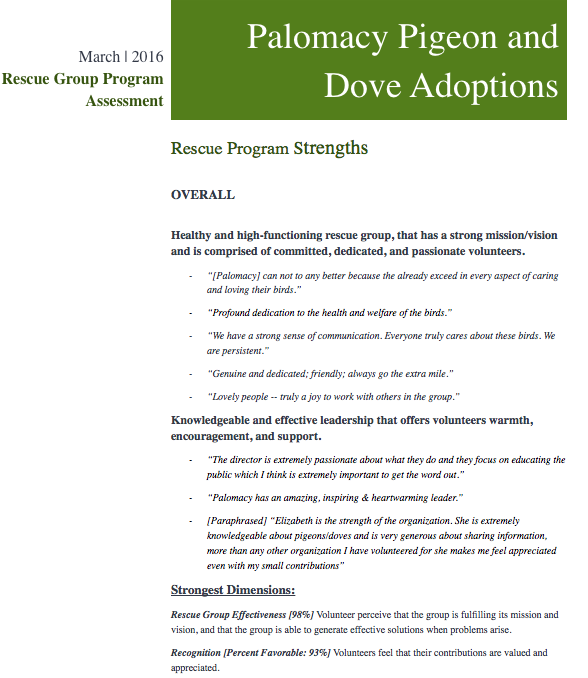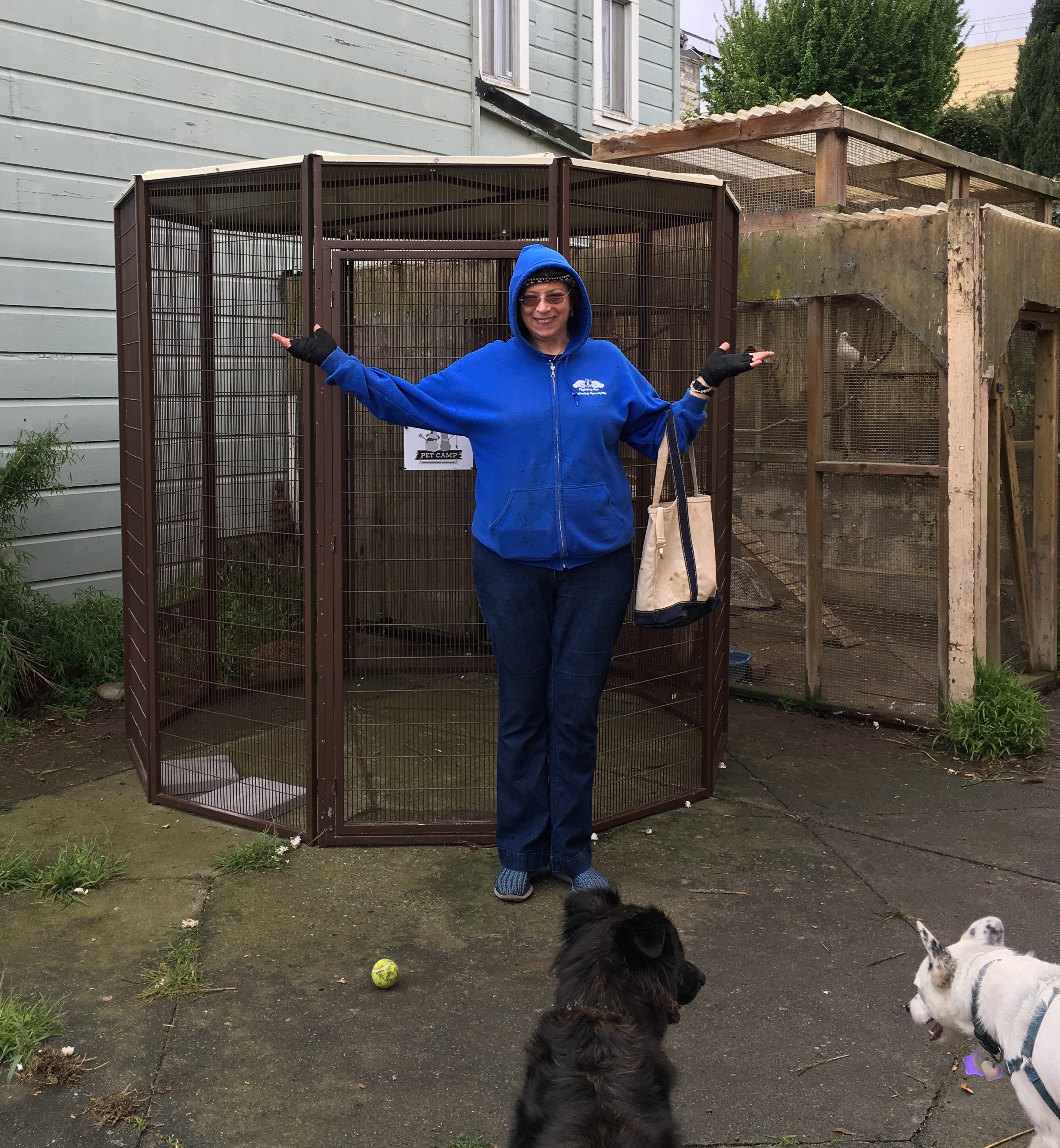Speaking of which, I’m very happy to say that Jessie is going to stay connected with us as a volunteer! She has lots of experience, expertise & information that can help us to thrive.
Rescue Program Strengths
OVERALL
Healthy and high-functioning rescue group, that has a strong mission/vision and is comprised of committed, dedicated, and passionate volunteers.
- “[Palomacy] can not to any better because the already exceed in every aspect of caring and loving their birds.”
- “Profound dedication to the health and welfare of the birds.”
- “We have a strong sense of communication. Everyone truly cares about these birds. We are persistent.”
- “Genuine and dedicated; friendly; always go the extra mile.”
- “Lovely people — truly a joy to work with others in the group.”
Knowledgeable and effective leadership that offers volunteers warmth, encouragement, and support.
- “The director is extremely passionate about what they do and they focus on educating the public which I think is extremely important to get the word out.”
- “Palomacy has an amazing, inspiring & heartwarming leader.”
- [Paraphrased] “Elizabeth is the strength of the organization. She is extremely knowledgeable about pigeons/doves and is very generous about sharing information, more than any other organization I have volunteered for she makes me feel appreciated even with my small contributions”
Strongest Dimensions:
Rescue Group Effectiveness [98%] Volunteer perceive that the group is fulfilling its mission and vision, and that the group is able to generate effective solutions when problems arise.
Recognition [Percent Favorable: 93%] Volunteers feel that their contributions are valued and appreciated.
Satisfaction with Communication [Percent Favorable: 91%] Volunteers feel that they know what is going on in the organization, that the rescue group goals are clear to them, and that the organization effectively communicates information to them.
Areas for Rescue Group Improvement
OVERALL
Greater participation of volunteers in rescue group leadership, decision-making, and information sharing.
- “Too much work is carried by the director.”
- “Not many volunteers are in leadership positions, creating a communication and decision bottleneck at the top.”
- “Overworked leaders.”
- “We need some volunteers who will really commit to sharing more of the organizational responsibility.”
Increasing recruitment efforts to grow volunteer program, and to have “more hands on deck” to assist with tasks and distribute the workload.
- “Lack of volunteers. (Though we have some many great ones.)”
- “Small organization which has to cover a lot of ground.”
- “Always in need of more people willing to foster birds and accessibility to affordable aviary options.”
- “Facing so much more need than we have resources to meet.”
Weakest Dimensions:
Perception of Voice [70%] Volunteers perceived that the rescue group could improve the opportunities that volunteers have to share and express ideas and concerns and participate in decision making.
Role Ambiguity [79%] Volunteers expressed that clarity around their volunteer assignments and responsibilities could be improved.
Satisfaction with Volunteer Coordination [78%] Volunteers reported that the coordination of their efforts, information sharing around who to direct their questions to, and the distribution of tasks and responsibilities could be improved.
Suggestions for Improvement
#1: Increasing the number of volunteers who are active in leadership roles, and participate in decision-making and information sharing, has the potential to:
- Increase perception of voice by allowing volunteers to actively share their insights, suggestions, and feedback
- Distribute workload so that the effectiveness of coordination efforts can be improved
- Decrease ambiguity around how task expectations and volunteer responsibilities
Increasing volunteer participation in these activities could be accomplished through:
- “Task Teams”: Groups of volunteers that work to solve a specific problem or accomplish a specific goal, and disband after this problem is solved or goal is accomplished.
- Additional Directorship and/or Coordinator Positions: Where volunteers can take on the responsibility of directing or coordinating specific sets of activities to improve rescue group coordination (i.e., Recruitment Director/Coordinator, Events Director/Coordinator, Adoptions Director/Coordinator, Outreach Director/Coordinator, etc.) for a pre-determined length of time.
- Regular Volunteer Meetings: where volunteers can come together (either in person or virtually) to address current or ongoing problems and voice their their insights, suggestions, etc. For example, at these meetings a “three questions/comments” policy can be implemented – where a specific number of questions/comments must be asked/stated to close the meeting to encourage information sharing.
- Providing an online “Suggestion Box”: where volunteers can easily submit suggestions/ideas/etc. for consideration.
#2: Growing the volunteer program through increased recruitment efforts has the potential to:
- Allow Palomacy to assist a greater number of pigeons and doves by having “more hands on deck” and decrease the workload of current volunteers and leaders.
- Provide greater latitude for “backup” or “substitute volunteers” to help ensure that volunteers tasks can be completed.
Recruitment efforts could potentially be increased by:
- Updating volunteer “job” descriptions: that include specific duties and desirable volunteer skill sets that can be disturbed to potential volunteers and used to evaluate the positions new volunteers would be best suited for.
- Soliciting support from current volunteers: in helping to manage and oversee recruitment efforts, and actively recruit potential volunteers through word-of-mouth, existing social networks, etc.
- Partnering with local/regional pet stores, veterinary practices, existing outreach groups, etc. that cater to or specialize in birds: working to gain their help in distributing recruitment fliers, both in person and/or through their existing listservs, twitter/facebook, other social media, etc. While ambitious, down the line perhaps even attempting to advertise and hold educational workshops [or ongoing volunteer training workshops] at these locations that are 1) open to the public [to draw in people who may be interested in volunteering) and 2) where, at the end of the workshop, Palomacy’s mission can be discussed and volunteer information can be distributed to attendees who are not already members of Palomacy.





